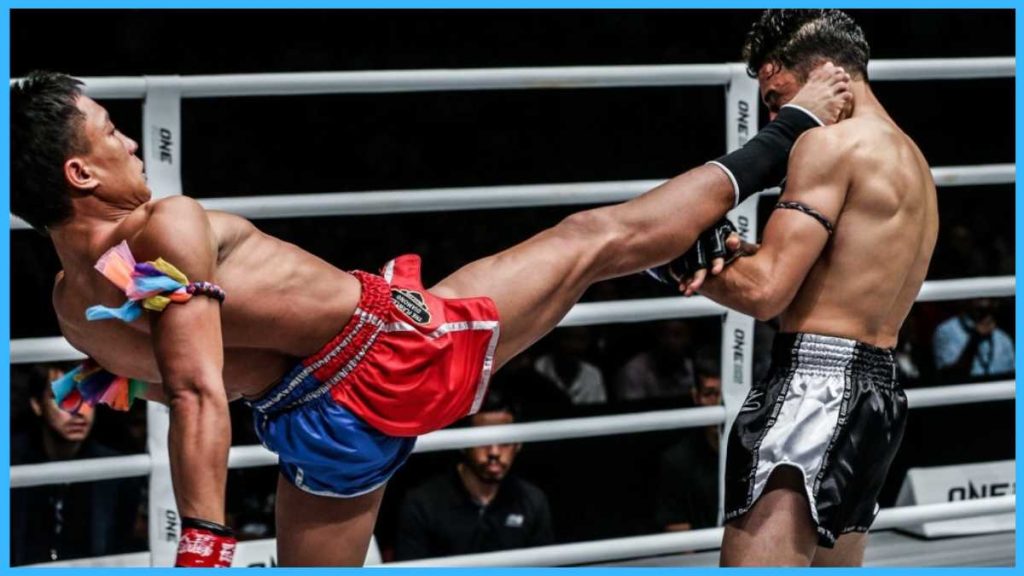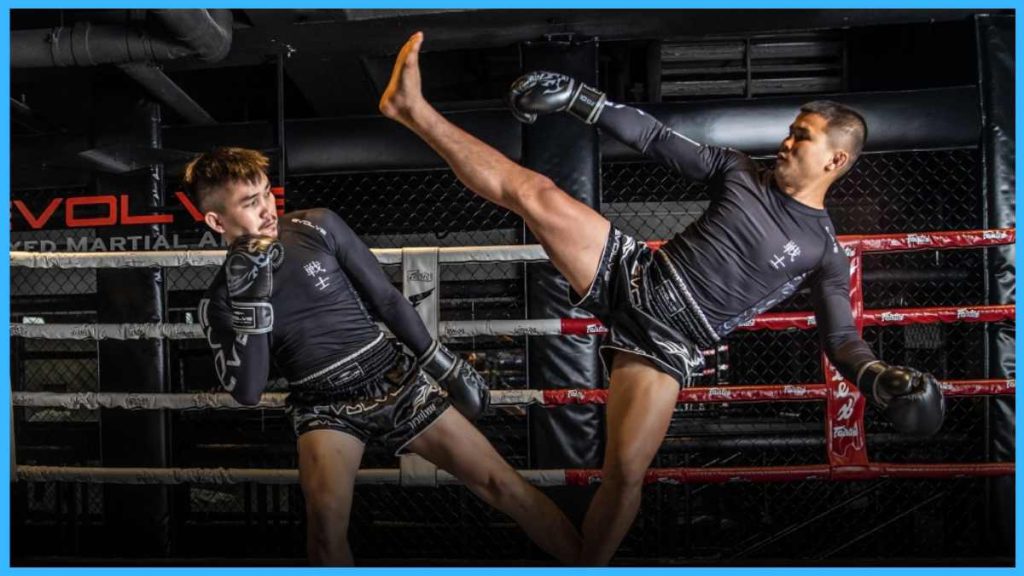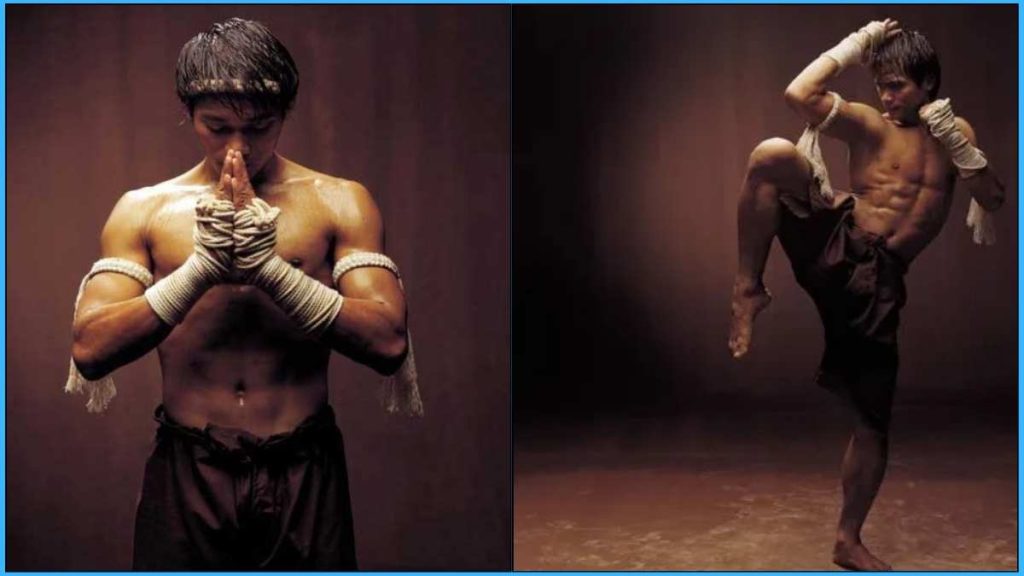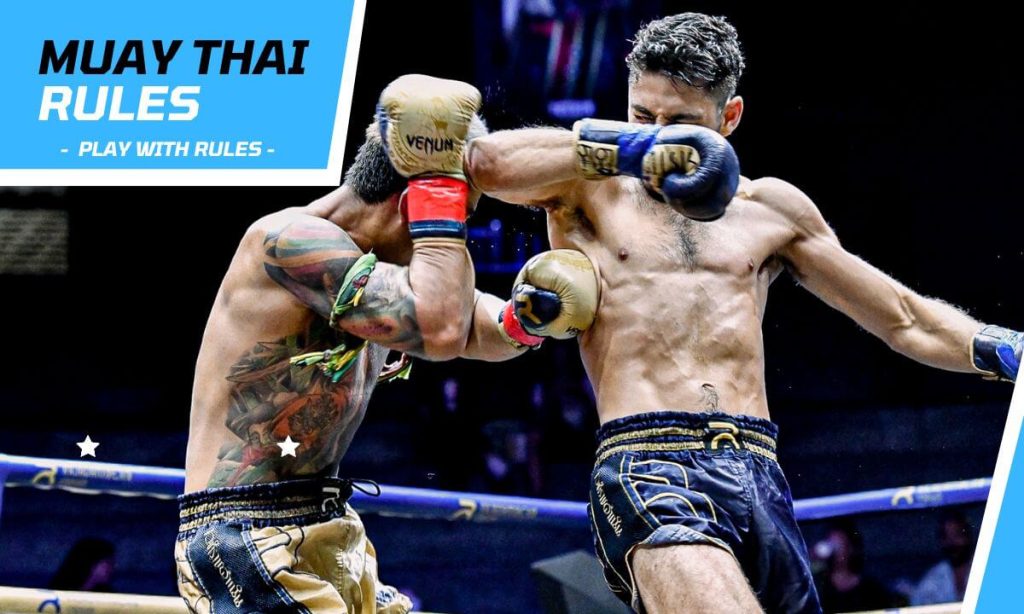Are you looking for Muay Thai rules and how to play it? You have come to the right place. The ‘Art of 8 limbs’ is what they call Muay Thai. For those yet to be acquainted with this form of martial arts, Muay Thai is one of the highest, most decorated, and most effective forms of self-defense. It is more than just another art form of fighting.
Muay Thai is a great full-body workout and a discipline that helps strengthen your mind. In fact, Muay Thai is widely regarded as one of the most effective striking techniques in the world. Today, we shall learn everything there is to know about this diverse, powerful, and discipline-driven combat sport.
Table of Contents
How To Fight Muay Thai?
The roots of Muay Thai can be traced back to Thailand, where it was practiced and developed over the years. In Muay Thai, fighters use their hands, legs, knees, shins, and elbows to land a combination of strikes to defeat opponents.
While it may seem like another fighting discipline, Muay Thai is much more advanced. It is about movement and strategy, combining all of that with well-calculated strikes. It trains the body and the mind at the same time.
Objective
The objective of a professional Muay Thai contest is to defeat your opponent. One can do this by either scoring higher than their opponent, knocking them out, or if their opponent is injured and cannot continue. However, the professionals have to follow Muay Thai rules while trying to knock their opponents out.

Muay Thai Rules
Muay Thai is a really effective and dangerous art form, which should be practiced cautiously. Specific rules and regulations must be adhered to when engaging in a Muay Thai contest. Here are some rules of Muay Thai that you need to be familiar with:
- Before the first round or starting the fight, each fighter must perform the ‘Wai Kru.’ Wai Kru is the traditional Muay Thai homage or tribute. So, both fighters must perform this tribute before the fight begins.
- Traditional Thai music is played during a fight using cymbals, java pipes, and two drums. The intensity of the music generally follows the flow and the intensity of the fight. However, the music can sometimes intensify to signal the Muay Thai fighters to be more aggressive.
- As for the basic Muay Thai rules, fighters can either wear boxing gloves (modern Muay Thai) or ropes around their fists (older style). Roped fists can deal more damage.
- You can punch, kick, knee, and elbow your opponents in Muay Thai.
- Muay Thai fighters are allowed to trip their opponents.
- If knocked down, a fighter has 10 seconds to return to their feet and show they can continue fighting. Failing to do so will result in the downed fighter losing the fight by KO (knockout).
- If neither fighter can knock the other out within the overall time of the match, or if both fighters are knocked out at the same time (not as common), then the judges score the fight (including the challengers’ performance) and declare the winner.
- Judges score fighters in each round. At the end of the fight, the fighter with the higher score is declared the winner (unless either fighter loses the fight earlier).
- If a fighter gets knocked down but manages to get back up on his feet before the 10th count, it is called a knockdown. The fight continues once both fighters are ready to resume.
- Clinching is allowed in Muay Thai (Clinching is basically where one or two fighters grapple with each other to inflict more damage and to get more tactical advantage).
- If a fighter suffers a blow to the groin area, then the referee can allow up to 5 minutes of rest time for the injured fighter.
- If the knee-struck fighter cannot continue or refuses to continue after that, he is eliminated, or the fight is declared as ‘no contest,’ as per the rules of Muay Thai.
1. Stance & Footwork
How you stand and use your body is pivotal in deciding how you fare in a fight. It is crucial to get your stance and footwork right while following the rules of Muay Thai. Here are some details about the same:
Stance
- Stand with both your feet together.
- Lift the toes on your right foot and pivot 90 degrees outward.
- Keep the toes on the floor, and lift the heel off the ground.
- Pivot your feet so that the toes face outward.
- Lift your toes up and rotate your feet out to a 45-degree angle.
- Lift your heel again and push your right foot back directly.
Footwork
Getting your stance right will give you more fluidity in your movements within the fight. It will anchor you, let you pivot, and generate more power in upper and lower-body strikes. A trained fighter is able to generate enormous power in their striking. It is important to stay light on your feet at all times. Depending on whether you want to attack or defend, you can use your front foot and your back foot to bob, wave, dodge, and advance.
So, what are the dos and don’ts of footwork in Muay Thai? Let’s get an overview:
- As per the rules of Muay Thai, Your feet should not be parallel to each other or shouldn’t be placed next to each other. If your feet cross each other, you will certainly lose your balance and, by effect, the fight.
- When advancing, make sure you push off the back foot for momentum and added force, and use the leading foot for direction and balance.
- When retreating or creating distance between you and your opponent, push off your leading foot, move backward, and use your back foot for balance and stability.
- Do not be rigid in your movements. Fluidity in movement is developed through practice, and you should strive for it. Stay light on your feet, and try to keep your movements as smooth-flowing as possible. Find a rhythm for your body, as it helps reduce exertion in motion.

2. Punches
Muay Thai relies heavily on both kicks and punches. Muay Thai Fighters can use a flurry of combinations of both to dominate their opponent, per Muay Thai rules. The punch is the most common form of striking in the discipline. Here are the different types of punches in Muay Thai:
Jab
The jab is the most important punch in combat sports. While it is unlikely that you will knock anyone out with a jab, it works marvelously in setting up heavier attacks and creating distance between you and your opponent. Here’s how to throw the perfect jab:
- Keep your elbows down and straight with your hands close to your chin.
- With the rear hand protecting the chin, use your lead hand to reach out and put your rear leg behind the movement for extra power.
- Rotate your wrist right before making contact with your opponent to create the snap effect.
Cross
The cross is another straight punch which is usually thrown as part of a combination with the jab. For example, the jab is referred to as ‘one’ while the cross is called ‘two.’ Here’s how to throw the perfect cross while following the rules of Muay Thai:
- Stay in a defensive stance with the lead hand to protect your face from counter-attacks.
- Use the rear arm to reach out and use the rear leg to generate more power.
- Twist the body in an anti-clockwise direction while throwing a punch.
- Pull back the punch straight away to ensure your own safety.
Hook
A hook can be thrown with either the right or the left hand. Unlike the other punching techniques mentioned above, the hook carries a lot of power and packs enough to knock out the opponent if landed the right way. Here’s how you throw a hook the right way in Muay Thai:
- Use your throwing hand (lead or rear) to throw a punch.
- Keep the throwing hand parallel to the ground and protect your chin with the rare hand.
- Keep your elbow up and your shoulders low.
- Keep your knees bent when throwing the punch.
- Pivot your right foot, shoulder, and hips to generate more power.
- Avoid winding up or over-extending.
Uppercut
Uppercut is probably one of the most powerful and effective punches in combat sport. The uppercut is a feared strike that has incredible knockout potential. It is difficult to predict or to defend because it comes up and lands on the chin from below. Here is how you throw an uppercut in Muay Thai:
- Maintain a defensive position and keep your chin covered with your rare hand (or the hand you aren’t throwing with).
- Keep your knees bent and push up using both legs.
- Use your lead hand or rear hand to drive up between the opponent’s defense towards the chin.

3. Muay Thai Kicks
All Muay Thai fighters rely heavily on kicks since they are the most important and effective striking technique in Muay Thai. Kicks generally pack more power and have more reach, making it an ideal way to strike your opponent. Some of the popular Muay Thai Kicks are as follows:
- Low Kick – This Muay Thai kick targets the opponent’s legs and thighs.
- Body Kick – This is a higher kick that usually targets the body.
- Switch Kick – This also targets the body but requires a quick switch between the rear and lead leg.
- Head Kick – This is a lethal kick that lands on the head.
Apart from the ones mentioned above, there are a bunch of other kicks that Muay Thai fighters use in a contest. They are as follows:
Push Kicks
- Front Push Kick
- Lead Front Teep
- Rear Front Teep
- Side Push Kick
- Jumping Switch Push Kick
- Slapping Push Kick
Knees
- Straight Knee
- Curved Knee
- Diagonal Knee
- Horizontal Knee
- Long Knee
- Small Knee
- Flying Knee
Defense
Blocking is an essential aspect of Muay Thai. It helps a fighter protect themselves when their opponent is striking. The most important way to protect oneself is by creating the right guard for the head. You can do that by making fists on either hand and keeping your hands close to your head. Your chin needs to be straight but slightly tilted, but always ensure that your vision is not blocked. Here is how you can defend in Muay Thai:
- Blocking – You can use your hands, legs, and elbows to block an attack. Forearms work well in defending attacks within a shorter distance. Lift the legs and use the shin to protect yourself against kicks.
- Dodging – Dodging is a great way to tire out the opponent and avoid being hit. This way, you don’t even have to absorb the minor damage you would otherwise have if you were blocking.
- Parrying – Parrying is a fluid, deflecting motion that directs kicks and punches away from the body. It relies significantly on technique and timing.
- Clinching – Clinching is used mainly as an advantageous striking position, but it can also work well in defending more powerful blows. It can also allow you to catch your breath and land some shots.
- Catching Kicks – Catching kicks is the best way to switch from defensive to attacking. It puts the opponent at a disadvantage, and you can have more control. However, it’s difficult to master since it requires impeccable timing and precision. However, you can only take up to two steps forward if you catch your opponent’s kick.
Fouls & Disqualification
When it comes to a fighting discipline as aggressive as Muay Thai, it is not uncommon for Muay Thai fighters to commit a foul, purposely or mistakenly. Depending on the nature of the foul, a fighter can either be let off with a warning or disqualified. Here are the rules regarding fouls and disqualifications in Muay Thai:
- Eye poking, biting, head-butting, spitting, or even sticking the tongue out at an opponent will result in a foul.
- As per Muay Thai rules, back-breaking, using wrestling or judo techniques to throw, arm-trapping, etc., are considered fouls.
- Grabbing the rope to fight an opponent or for any other reason during the fight.
- Going after a downed opponent trying to get up is not allowed. You cannot fall over the downed fighter, either.
- Disobeying the referee’s commands or instructions will result in a foul.
- Any provocative behavior during the fight will result in a foul.
- A knee strike to the groin area will be declared a foul.
- Catching the opponent’s kick and pushing more than two steps without striking or using any attacking techniques will result in a foul.
- A fighter cannot fall to the floor once an opponent catches his leg. If he does so purposely, he is considered to be taking advantage of the opponent and will be declared a foul.
- If both fighters fall out of the ring and both or either fighter purposely delays getting back in the ring, it will be a foul.
- Using all substances banned by WADA will result in fouls and maybe even disqualification.
- Muay Thai Fighters lose one point if they are given a warning.
Note: As mentioned earlier, the referee will mostly caution the fighter who commits the foul for the first two times. After that, the fighter will be warned. Three fouls will result in a disqualification.

Muay Thai Scoring
Judges score fighters based on their dominance, technical prowess, and overall superiority in each round. A winner will be scored 10, while the other fighter can be scored 9, 8, or even 7, depending on his performance in that round. If both fighters perform equally well, then it results in a tie for that round, with both fighters being awarded 10.
- 10:9 – A 10:9 score means that the fighter scoring ten has won the round.
- 10:8 – A 10:8 score means that the fighter scoring 10 points has won the round by a clear margin.
- 10:7 – A 10:7 round means that one fighter has won clearly, and his opponent has been downed and received a count from the referee.
Winning
There are three ways to win in Muay Thai. You can win by a Knockout (KO), Technical Knockout (TKO), or Judges Scores.
- KO—A KO is when a fighter knocks out another fighter completely, stopping the fight immediately.
- TKO – A TKO is when a referee intervenes and stops the fight if they see that one of the fighters cannot defend themselves further.
- Judges’ Scores—A win by judges’ score means that one fighter displayed more aggression, skill superiority, and dominance and was clearly the better fighter of the two.
Tips & Strategies
Although it is quite an old martial art form, it is only recently that Muay Thai has been getting recognition worldwide. Today, it is quite a popular sport, attracting crowds from all around the world. Naturally, there are skilled fighters in the sport who use specific strategies to help them be better than the rest. Here are some essential tips and techniques that you can use to get better at Muay Thai:
- Work on your defense – Working on your defense might sound boring, but a sound defense will win you matches and protect you and your body. Work on your head movement and track the shoulder movements of opponents to help you dodge attacks. Using the forearms and the legs to defend is quite effective, but learning how to parry will give you more room to respond with a counterattack, and it will hurt less.
- Strengthen your body – Work on your body and ensure you are ready to eat a few strikes. In Muay Thai, it is impossible not to absorb any strikes. So ensure your forearms, legs, and body are strong enough to absorb strikes.
- Combination of strikes – Practice switching between your stances and your striking techniques. The idea is to keep the opponent guessing. Using a combination of strikes, you can create opportunities for yourself and increase your chances of knocking out your opponent (which is the most assertive way to win).
- Clinching and sweeping – Clinching can give you an advantageous position. From there, you can decide if you want to land shots to the body or if you want to sweep the leg and drop your opponent.
- Breathing techniques—Work on your breathing because it will make a difference in the fight. Using the right techniques and practicing breathing exercises will increase your stamina and endurance, which is crucial in Muay Thai.

Different Types Of Muay Thai
While the combat sport acts like an umbrella for different striking and fighting styles, several different Muay Thai styles exist. Every fighter has a distinct style they develop in training and resort to. Here are some of the various types of Muay Thai:
- Muay Tae – Focuses on specialized and powerful kicks.
- Muay Mat – Focuses on solid punches to the head and body, accompanied by Muay Thai kicks.
- Muay Khao – Focuses on strong knee attacks.
- Muay Femur – Focuses on precision, technique, and skills.
- Muay Sok – Focuses on the proper use of elbow in fights.
- Muay Lopburi – A modern take on Muay Thai that incorporates modern boxing techniques.
- Muay Chaiya – Focuses on the traditional Muay Thai techniques and strategies.
- Muay Bouk – The most aggressive style encourages non-stop aggression and pressing.
Did You Know?
- Muay Thai is the national sport of Thailand.
- King Rama VII of Thailand played a pivotal role in shaping Muay Thai and making it the popular sport that it is today.
- The intensive training and sparring sessions of Muay Thai are said to burn around 1,000 calories per hour.
- In 2018, UNESCO recognized Muay Thai as an intangible cultural heritage of Thailand.
- Muay Thai is a crucial component of striking in MMA, which is why many MMA fighters train extensively in Muay Thai.
FAQs
Is Muay Thai all about striking?
Mostly! Muay Thai doesn’t allow grappling and takedowns. It is a sport that encourages and cultivates striking techniques besides the occasional sweeps.
Can I kick an opponent in the head in Muay Thai?
Yes, you can. Kicking the body, including the head, is allowed. However, attacking the groin area is a big ‘no’ and can result in a disqualification.
Are there weight classes in Muay Thai? Or can I fight anyone?
There are weight classes in Muay Thai to ensure fair competition.
Is Muay Thai practiced only in Thailand?
Not necessarily. Many famous MMA fighters also practice Muay Thai, which originated in Thailand but has spread worldwide ever since.
Are any kicks illegal in Muay Thai?
Yes, some kicks are illegal in Muay Thai. For example, kicking a downed opponent is prohibited. Additionally, certain techniques like the cartwheel kick, which involves touching the ground with the hand before striking, are technically illegal but often accepted if executed quickly and with flair.
Is pushing legal in Muay Thai?
Yes, pushing is legal in Muay Thai. It is used to create distance, disrupt an opponent’s balance, or set up strikes. However, pushing must be done with an open hand or forearm and should not target the face. Continuous pushing is not allowed and can result in penalties.
What are the basic principles of Muay Thai?
The basic principles of Muay Thai include using eight points of contact (fists, elbows, knees, and shins) to strike opponents. It emphasizes powerful strikes, effective clinching, and strong defensive techniques. Muay Thai also values discipline, respect, and fair play, with rules in place to ensure safety and fair competition.
While Muay Thai might have been developed for self-defense and real-life battlefield applications, deep respect for Thailand’s culture and tradition has always been maintained. Even to this day, Muay Thai is respected widely as one of the most effective and dangerous fighting styles, and professional fighters are urged to train in it for better striking techniques. And now that you know the rules of Muay Thai, you can move on to learn about a new sport – a sport that is quite like Muay Thai but has its own set of rules.
Are you interested in fighting styles and disciplines? We have a couple more styles you might want to read about. Do you know the rules of Kickball? Click here to find out now!

